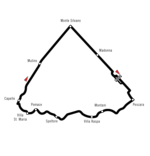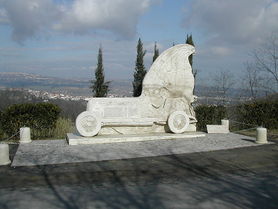Pescara Grand Prix
| Pescara Grand Prix | |
|---|---|

| |
| Laps | 18 |
| Circuit length | 25.58 km (15.89 miles) |
| Race length | 460.42 km (268.09 miles) |
| Most wins by single driver | Stirling Moss (1) |
| Most wins by single constructor | Vanwall (1) |
| Last race (1957): | |
| Winner | Stirling Moss |
| Winning constructor | Vanwall |
| Winning time | 2:59'22.700 |
| Pole time | 9:44.600 |
| Pole driver | Juan Manuel Fangio |
| Pole constructor | Maserati |
| Fastest lap | 9:44.600 |
| Fastest lap driver | Stirling Moss |
| Fastest lap constructor | Vanwall |
The Coppa Acerbo was an automobile race held in Italy, named after Tito Acerbo, the brother of Giacomo Acerbo, a prominent fascist politician. Following Italy's defeat in World War II, and the consequent demise of fascism, the race was renamed the Circuito di Pescara, and in some years was also referred to as the Pescara Grand Prix (Gran Premio di Pescara). The race was run between 1924 and 1961 and over the years was held to a variety of vehicle class regulations and durations. In 1957 the Pescara Grand Prix formed a round of the Formula One World Championship, a race which still holds the record as having the longest circuit length ever used for a Championship event.
Pescara Circuit
The Coppa Acerbo races were held over a 15 - 16 mile (24 – 26 km) circuit, beginning and ending at Pescara, on the Adriatic coast. The course layout featured an inland route through the Abruzzo hills, that passed through several villages, followed by a long, straight descent back to the coast, where a tight right-hand corner led on to a four mile (6 km) long straight running next to the sea. The pit and paddock complex was located at the end of this straight. In an effort to slow competitor speeds past these pits the Pescara circuit became one of the first to have an artificial chicane installed, just before the pit lane. The Pescara circuit layout holds the record as the longest circuit to ever to host a Formula One World Championship event, with the Nürburgring Nordschleife coming second at ~23 km.
Pre-war races

The first Coppa Acerbo was staged in 1924 and was won by a then-unknown junior driver by the name of Enzo Ferrari, later to find fame as the creator of Ferrari and head of the Formula One team Scuderia Ferrari. The race was run for the top class of international competition, the only real limiting factor on vehicle specifications being the cars' ability to transmit power through the inadequate tyres of the day. Although never itself a Grande Epreuve, or later a constituent of the European Championship, the Coppa Acerbo was considered one of the most prestigious races of its day. These early races were dominated by home-grown cars and drivers, and Alfa Romeo in particular was almost unbeatable. The Milanese manufacturer won seven of the first nine races; only in 1926 were they beaten by the legendary Bugatti T35, and again in 1930 by Italian star-driver Achille Varzi driving a Maserati.
Alfa's domination of the race came to an end with the introduction of the 750 kg Grand Prix regulations in 1934, a race that was also marked by tragedy when Guy Moll, one of the most promising young drivers of the day, was killed. Germany's state-funded Silver Arrows of Mercedes-Benz and Auto Union would come to eclipse all their rivals for the subsequent five years. Although the race was again won by two Italian drivers during this time, including a second victory for Varzi, it was only when the organisers decided to run the Coppa to the 1.5 litre voiturette formula in 1939 that any other manufacturer could stand a realistic chance of winning. Perhaps fittingly it was Alfa Romeo, with their new 158 Alfetta car, that took the honours in this last competition before the outbreak of World War II.
Post-war races
After WWII the race remained suspended for a year during post-war rebuilding. When it was finally run again in 1947 the name of the race was changed, because of its fascist connections, and it became known as the Circuito di Pescara. For the first three years the race was run for two-seater sports cars and was a fairly minor constituent in the European racing calendar. However, in common with many race orgaisers around the continent, with the introduction of the Formula One World Championship in 1950 the race organisers saw their chance to return the Pescara event to its former position of prominence. Although, once again, not a World Championship event the race did attract many top-name teams and drivers over the following two years. Despite it being an Italian event, and himself a former winner, Ferrari decided to withdraw his team from the 1950 event, but the Alfa Romeo, Maserati and Talbot-Lago works teams did attend, along with many privateer and amateur racers. The 1950 race was won by future World Champion Juan Manuel Fangio driving for Alfa Romeo. The following year Ferrari did attend, and the race was won by Fangio's Argentinian compatriot José Froilán González driving one of their 375 cars.
When the World Championship switched to the slower Formula Two regulations, the organisers decided to abandon formula racing in favour of further sportscar events. During this period endurance sportscar racing was almost as prestigious as the top open-wheel series, and for 1952 the organisers changed the race's name, once again, to the 12 Ore di Pescara (12 Hours of Pescara). The change of format did not hinder Ferrari's chances of victory, however, and their cars and drivers took wins in both 1952 and 1953. Despite the success of the endurance format, though, when the Formula One engine capacity limit was raised to 2.5 litres from 1954 the Circuito di Pescara was quickly switched back to single-seat rules. The 1954 event was won by one of the most iconic Formula One cars of all time, a Maserati 250F, driven by Luigi Musso. This was to be the last race for two years, as in 1955, as a result of the disaster at the 24 hours of Le Mans, the race was cancelled.
Sportscars returned once more in 1956, before in 1957 the Pescara race was elevated to a round of the Formula One World Championship. This race, although commonly referred to as the 1957 Pescara Grand Prix was officially another Circuito event. In a field dominated by numerous Maserati 250F cars, reigning World Champion Fangio used his example to set a pole position time of 9 minutes 44.6 seconds, at an average speed of over 157 km/h (98 mph). In the race, however, it was second-placed starter Stirling Moss in his Vanwall who took the initiative and victory. He led all but one of the race's 18 laps and finished over three minutes clear of Fangio in second place.
By the early 1960s, safety issues had become a major concern and the Pescara racecourse was seen as too dangerous for major international events. After a two year break the race was downgraded to Formula Two status for 1960, a race won by future World Champion Denny Hulme in his first year racing in Europe. For its 1961 swansong once again, for only the second time in its history, the Pescara race was raised to World Championship status, this time in the World Sportscar Championship. Appropriately, for a race subtitled the 4h Testa Rosa, the final Gran Premio di Pescara was won by a Ferrari Testa Rossa, driven by Lorenzo Bandini and Giorgio Scarlatti and entered by Scuderia Centro Sud; an Italian team, with an Italian car and two Italian drivers, won the final iteration of this famous Italian event. With ever-increasing speeds and the fragile build-quality of most cars of the time, the race was discontinued after the 1961 event.
Winners of the Pescara Grand Prix
| Year | Driver | Constructor | Location | Report |
|---|---|---|---|---|
| 1957 | Vanwall | Pescara | Report |
For details on other winners between 1924 and 1961, see Coppa Acerbo.
Video
| Tribute to Grand Prix of Pescara |
|---|
External Links
Etracksonline page on Pescara circuit
| Races in the Formula One championship: | |
|---|---|
| 2007 championship Grand Prix events: | |
|
Australian |
Malaysian |
Bahrain |
Spanish |
Monaco |
Canadian |
U.S. |
French |
British | |
| Past championship Grand Prix events: | |
|
Argentine |
Austrian |
Dutch |
Indy 500 |
Las Vegas |
Luxembourg |
Mexican |
Morocco | |
| Confirmed future Grand Prix events: | |